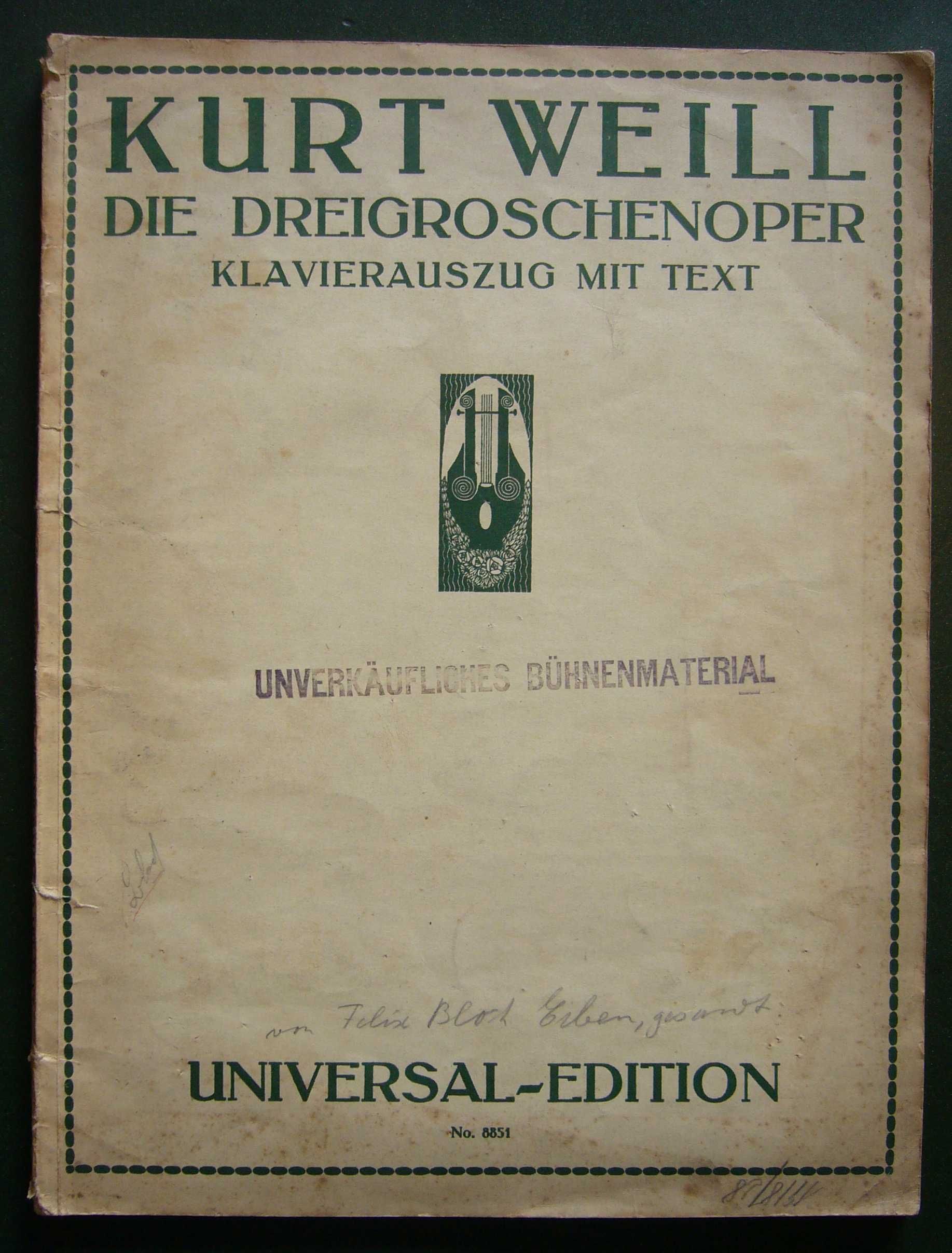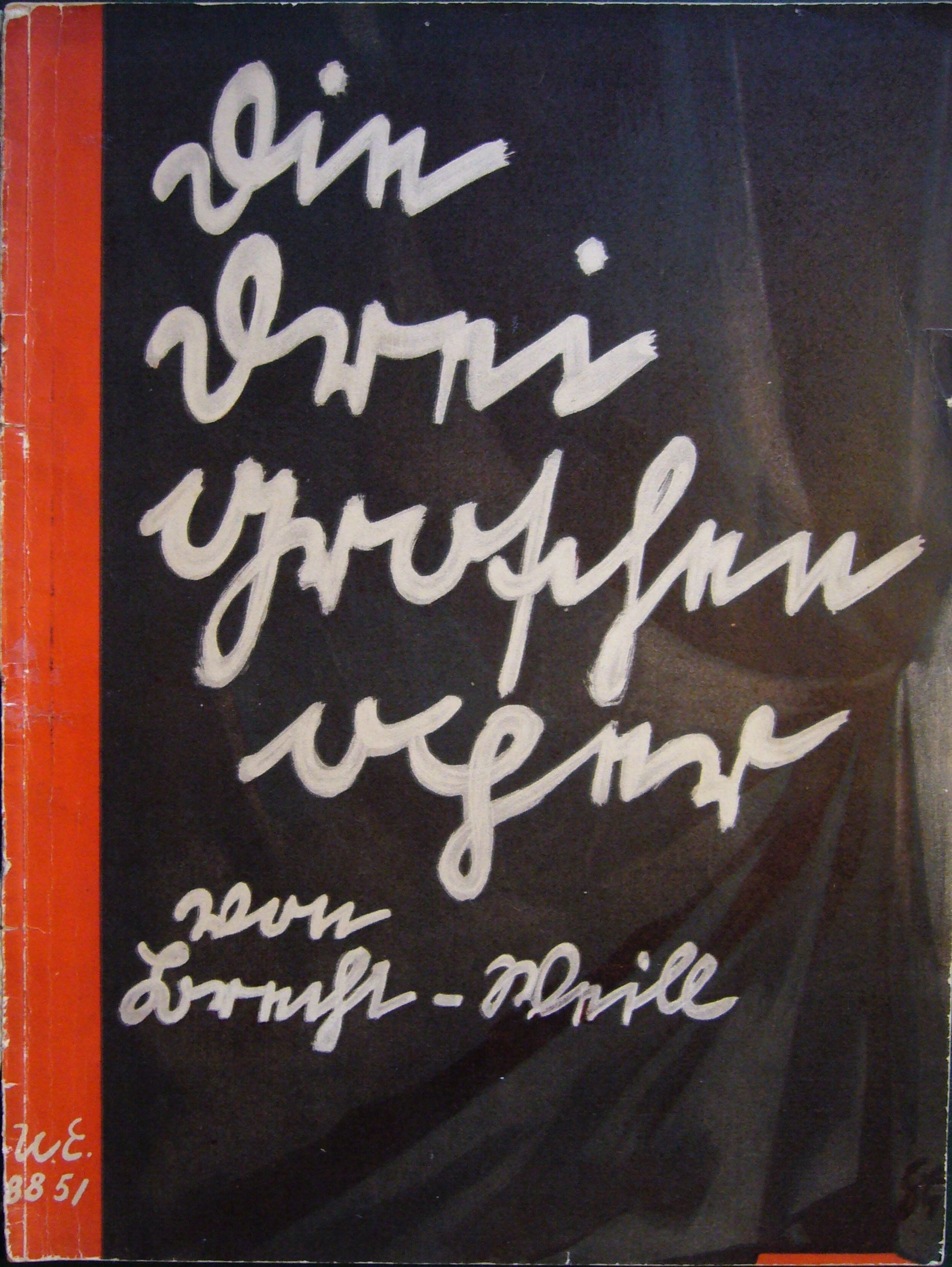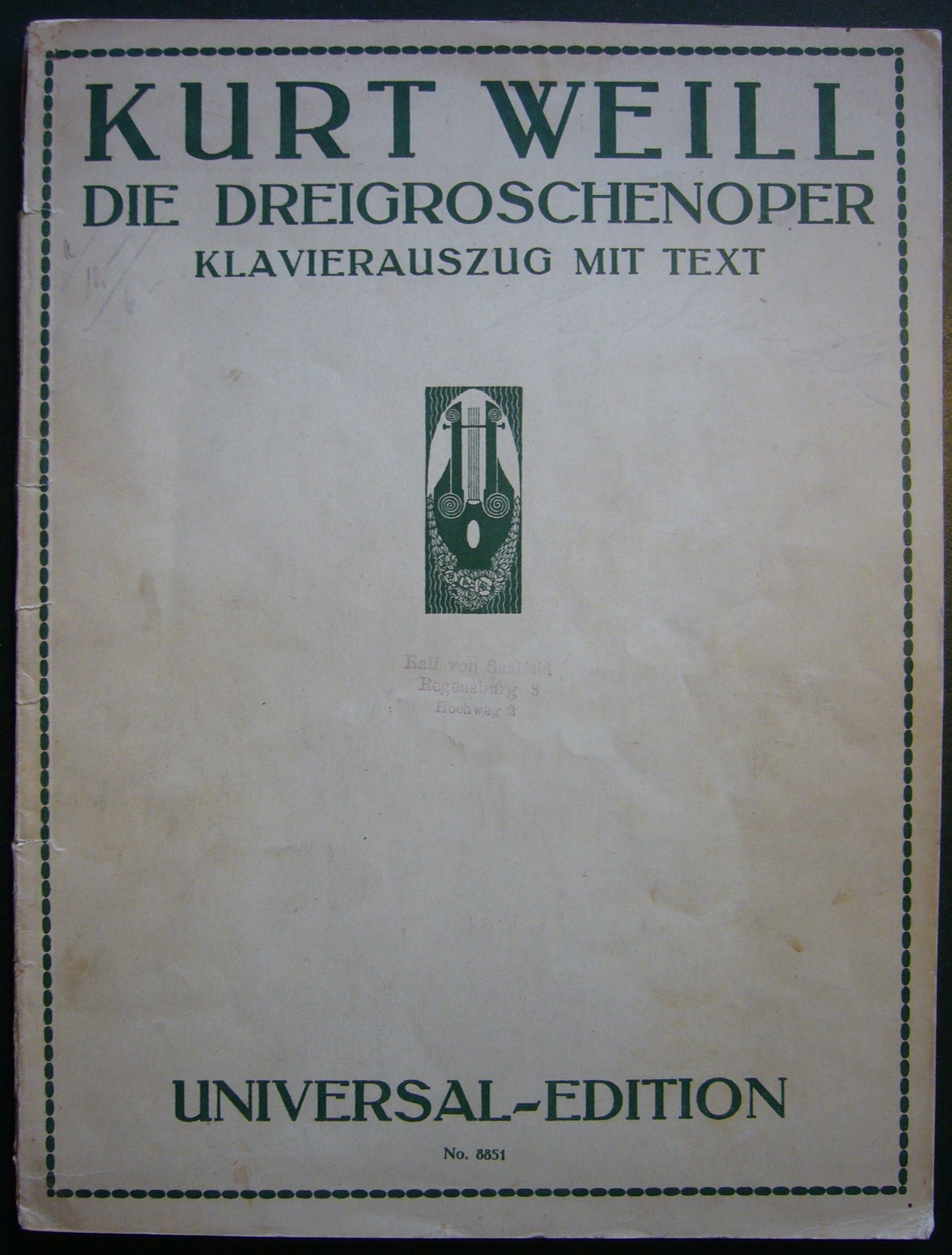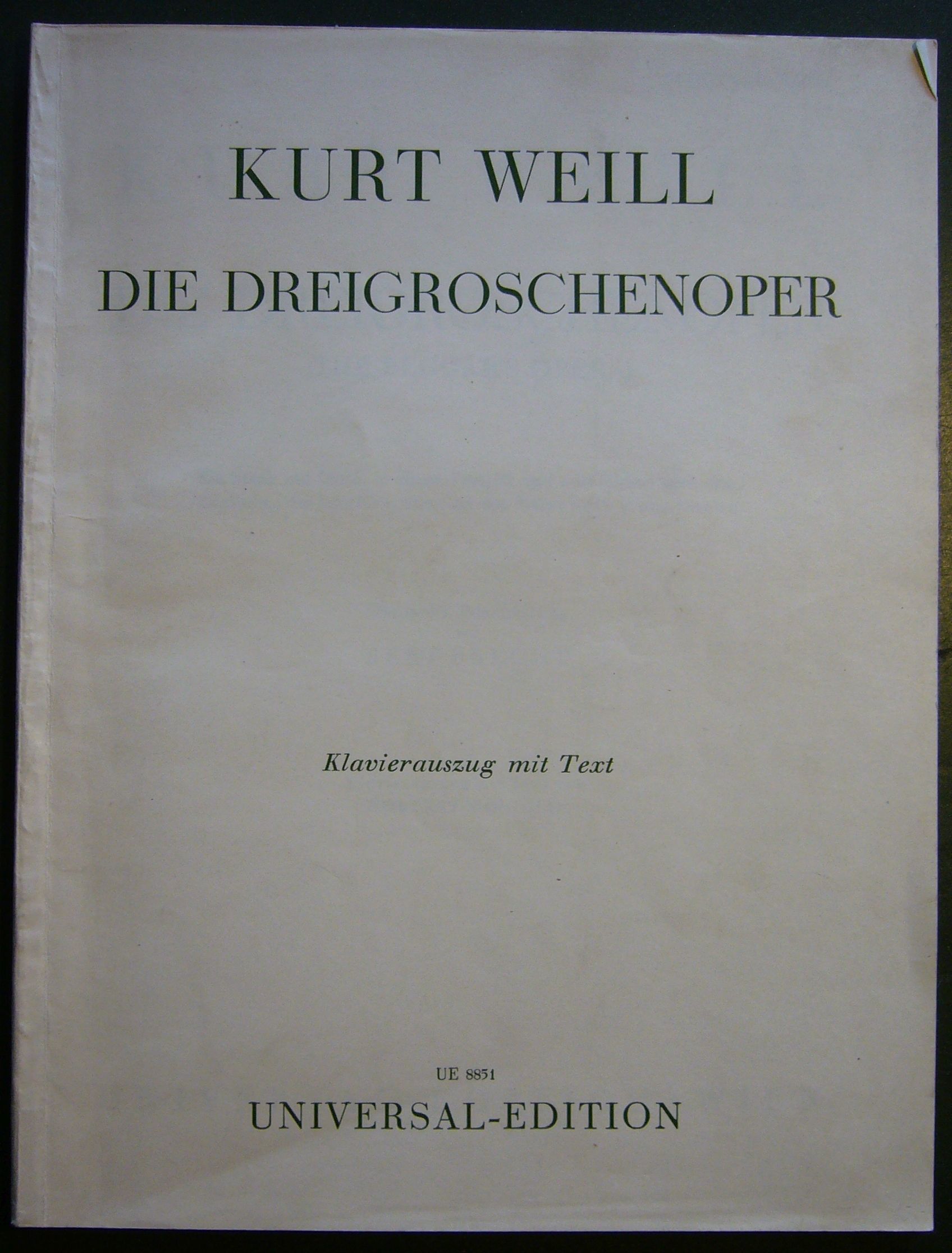Dreigroschenoper
- the printing history of the vocal score UE 8851 -
The following presentation tries to give a detailed description of the publication history of the piano reduction of the Dreigroschenoper (Threepenny opera) by Kurt Weill and Bertold Brecht in chronological order. The publication history follows the dates the archive of Universal Edition provided to me and which are also presented in the doctoral thesis of Stephane Buchon. These dates come from the producing index (Verlagsbuch) of the archive and contain the information on which day shipments from the printing firm arrived at the publishing house. As one can see the number of copies in each printing run are strangely odd (not 250 or 300, but for example 293) and differ from one run to the next. A possible explanation for these peculiar numbers came from the renowned literary scholar and Brecht expert Jan Knopf. He told me that Universal Edition printed scores and also librettos of the Brecht/Weill compositions "on demand" at that time. If that is true UE did not print as many scores as they suggested to be sold in total, but only as much as the market requested at a time.
Due to the small number of existing copies of UE 8851 I made some basic assumptions in the very beginning of my research:
- copies of a single printing run do not differ from each other.
- the use of a new cover is obligatory after a cover change and there is no return to the original cover
- corrections in the musical notation are obligatory after a revision and there is no return to the original ("wrong") notation
These assumptions led easily to a printing order of the variants. But then I received more information about copies preserved in libraries and archives. Some of these copies have characteristics that were in conflict with my initial, "logical" order. Therefore I had to adjust my printing order several times and now face the fact that there is no logical printing history. For that reason my actual presentation is based only on existing copies and I omitted every speculation. There is a good chance that more copies will come up in the future and reveal information that force further adjustments. Therefore check this website from time to time to learn about the latest state of research.
For a quick overview and fast identification please have a look at the following table. It provides the code for each specific printing date and the characteristics of the corresponding printing. For further details check the descriptions below the table:
| delivery date (run) | cover | printer date on back cover | bass line on p.54 | typo in cast | |
|---|---|---|---|---|---|
| A1 | 02.11.1928 (293-A2) | green | X. 1928 | original | yes |
| A2 | 02.11.1928 (293-A1) | coloured | blank back cover | original | yes |
| B | 23.11.1928 (298) | coloured | blank back cover | original | no |
| C1 | 31.12.1928 (294 or 225) | green | XII. 1928 | original | no |
| C2 | 31.12.1928 (294 or 225) | coloured | ? | ? | ? |
| D1 | 30.01.1929 (E1+E2=497) | coloured | I. 1929 | original | no |
| D2 | 30.01.1929 (E1+E2=497) | coloured | I. 1929 | corrected | no |
| E1 | 09.04.1929 (196) | green | III. 1929 | original | no |
| E2 | 09.04.1929 (502) | coloured | ? | ? | ? |
| F | 03.06.1929 (999) | coloured | ads, but no date | corrected | no |
| G | 03.01.1930 (298) | ? | ? | ? | ? |
| H | 13.01.1930 (503) | ? | ? | ? | ? |
| I | 30.09.1932 (253) | ? | ? | ? | ? |
Timeline of the printing history
31 August 1928
On this day the world premiere of the Dreigroschenoper took place at the Theater am Schiffbauerdamm in Berlin (Germany).
28 October 1928
On this day Universal Edition commissioned the printing firm Waldheim-Eberle A.G. for the first time to print copies of the piano reduction of the Dreigroschenoper.
2 November 1928
Universal Edition received 293 copies of the very first copies of the piano reduction
variant A1
These copies can be identified by the following characteristics:
front cover: Light green paper. Recto: Green dotted border. Within the border the following green text: "KURT WEILL / DIE DREIGROSCHENOPER / KLAVIERAUSZUG MIT TEXT / [company emblem depicting a lyra] / UNIVERSAL-EDITION / No. 8851". Verso blank.
title page: White background, black double-lined border. Within the border the following black text: "KURT WEILL / DIE / DREIGROSCHENOPER / (THE BEGGAR'S OPERA) / Ein Stück mit Musik in einem Vorspiel und acht Bildern nach dem / Englischen des John Gay, übersetzt von E l i s a b e t h H a u p t m a n n / Deutsche Bearbeitung / von / Bert Brecht / Klavierauszug mit Text von / NORBERT GINGOLD / AUFFÜHRUNGSRECHT VORBEHALTEN - DROITS D'EXÉCUTION RÉSERVÉS / UNIVERSAL-EDITION A. G. / WIEN / Copyright 1928 by Universal-Edition / LEIPZIG". At the bottom, outside the border the text: "Printed in Austria"
inside:
[1]: title page
[2]: copyright statement
[3]: cast
[4]: index of acts
5 - 73: piano reduction
[74] blank
back cover: Light green paper. Recto blank. Verso a green double-lined border. Within the border advertising for other UE publications. For an exact presentation please check the photo below, the most important information is which works and editions are offered: "KURT WEILL / BÜHNENWERKE / DER PROTAGONIST [with UE 8387 and 8388] / DER ZAR LÄSST SICH PHOTOGRAPHIEREN [with UE 8964 and 8965] / ROYAL PALACE [with UE 8690 and 8691] / MAHAGONNY [with UE 8917] / DIE DREIGROSCHENOPER [with UE 8851] / ORCHESTERWERKE / op.9 QUODLIBET [with UE 8348] / op.12 KONZERT [with UE 8339] / KAMMERMUSIK / op.8 STREICHQUARTETT I [with UE 7699 and 7700] / KLAVIER ZU 2 HÄNDEN [with UE 8848] / op.10 FRAUENTANZ [with UE 7599 and 7748] / GESANG UND KLAVIER [with UE 8900, 8847 and 8862] / ZU BEZIEHEN DURCH JEDE MUSIKALIENHANDLUNG / Prospekte mit Pressestimmen über Kurt Weills Werke gratis von der / UNIVERSAL-EDITION A. G., WIEN-LEIPZIG". At the bottom left, outside the border "No. 131 X. 1928."
spine: Light green paper, in green letters: "U. E. 8851, KURT WEILL, DIE DREIGROSCHENOPER, KLAVIERAUSZUG MIT TEXT"
last music page: On the last page 73, at the bottom left, the printing firm left its acronym "Weag"
I know of two existing copies of this first edition: One at the Chopin University of Music in Warsaw (Poland) and one in my possession. But the copy in Warsaw is incomplete, missing front and back cover and could only be identified through the typo in the cast on page 3 (see below).
My copy has the following additional attributes:
front cover: On the recto is the stamp "Unverkäufliches Bühnenmaterial"
title page: a pink label was glued on the page saying "Den Bühnen gegenüber als Manuskript gedruckt / Das Aufführungsrecht ist allein zu erwerben von dem Verlage / Felix Bloch Erben / Berlin-Wilmersdorf 1, Nikolsberger Platz 3" and at the bottom, outside the border, under "Printed in Austria" is again the stamp "Unverkäufliches Bühnenmaterial"
I contacted Felix Bloch Erben and asked if they still know the number and recipients of the copies with their pink label on it. Unfortunately they had no answer to this question.
This variant also has three characteristic criteria, that are missing to the variants B to L - one on the front cover, one on the back cover and one on page 3:
1) There is a typo in the cast (page 3): There the bandits are named with a bracket on the right. On the very right it says "Macheats Leute" (missing the h). This typo does not appear in later versions. (see photo below)
2) On the back cover under the header "Kammermusik" the "Streichquartett I" is listed. Behind the plate number 7699 is says "Partitur 16°" with a superscripted 0. This superscripted 0 does not appear in later versions.
3) On the front cover the distance between the phrase "Klavierauszug mit Text" and the company emblem is 2,2 cm. The distance in later editions is 2,8 cm.
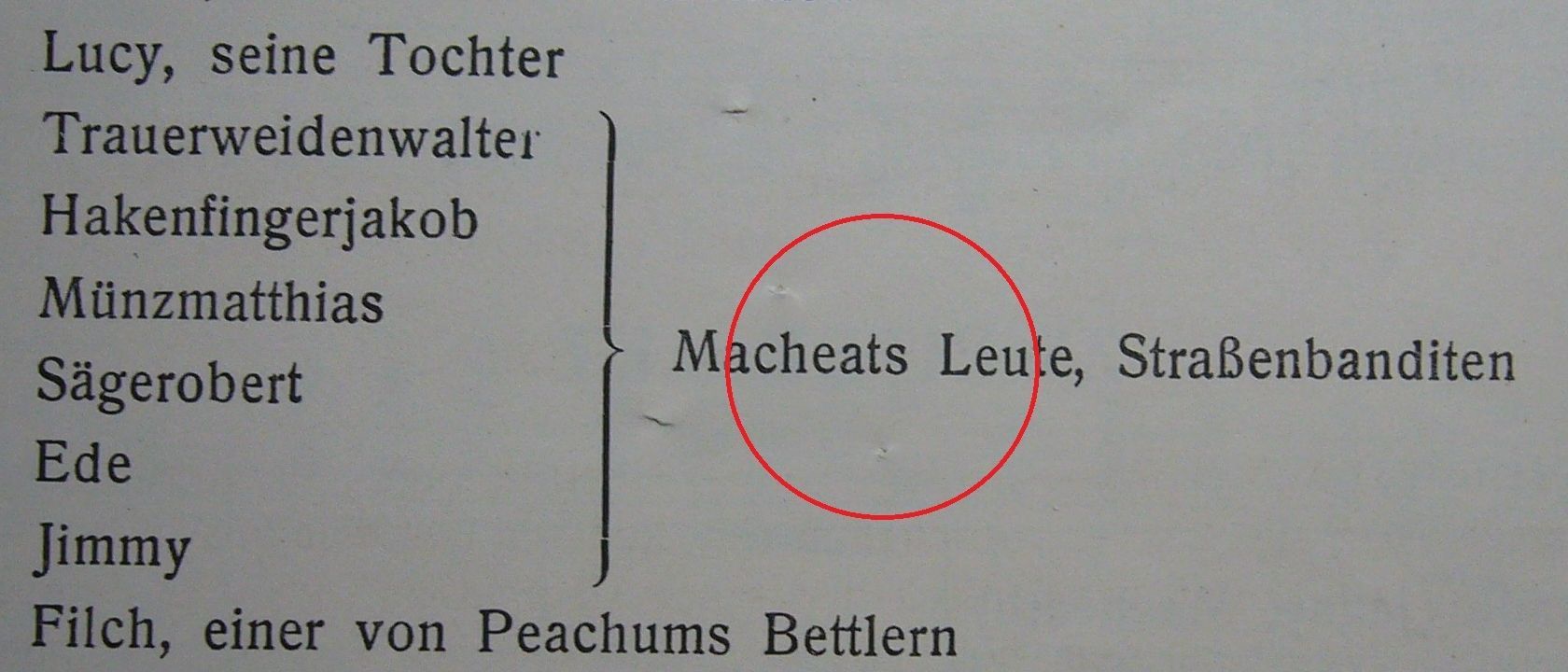
Important for the differentiation between earlier and later editions is the bass line of the measures 22 and 23 of the 2. Dreigroschenfinale (p.54). The first edition, first printing shows this "original" version:

2 November 1928
variant A2
The existance of this variant is based on a copy preserved at the Ratsschulbibliothek Zwickau (Germany). This library holds a copy that looks like this:
This variant is identical to A1 in the inside, but front cover, back cover and spine are different. In the following I describe only the differences between variant A1 and A2:
front cover: dark background depicting a painted curtain, on the left side a red stripe. On the bottom of the red stripe stands in a handwriting font in white colour "U. E. / 8851". On the dark part of the front cover in a handwriting Kurrent font in white colour stands "die / drei / groschen / oper / von / Brecht-Weill". Verso blank.
back cover: completely blank
spine: White paper, in black letters, italic: "U. E. 8851, KURT WEILL, DIE DREIGROSCHENOPER, KLAVIERAUSZUG MIT TEXT"
The copy in the Ratschulbibliothek Zwickau also has the typo in the cast. In addition it has an inscription of a former owner: "Kurt A. Haase, Spielleiter und Dramaturg z.zt. post kraftsdorf thür. harpersdorf" and a time stamp "13.Nov.1928". This lead to the delivery date 2 November 1928.
23 November 1928
According to the printing book of the Universal Edition the next shipment of copies arrived on this day from the printing firm. Now a total of 298 copies were delivered.
variant B
For the identification of the variant that was printed in this run a copy at the Staats- and Stadtbibliothek Augsburg (Germany) is important. Their copy looks identical to A2, but does not have the typo in the cast! Additionally it was inscribed by Bertolt Brecht on the title page: "lisbeth für weihnachten 28 / herzlich / bert / berlin". That means Bertolt Brecht received this copy before Christmas 1928 and due to the fact that the copy looks different to the one described in A1 and A2, it must be a copy from this run.
31 December 1928
According to the printing book of the Universal Edition the next shipment of copies arrived on this day from the printing firm. Now a total of 294 and 225 copies were delivered. Unfortunately UE only provided these two numbers without any explanation, but with a green cover in A1 followed by a coloured cover in A2 and B, it seems likely that these two amounts refer to the number of green and coloured cover copies.
variant C1
This edition is the one with the green cover which is identical to A1 except of the printing date "XII. 1928." on the back cover. It also misses the three special characteristics of A and therefore has no typo in the cast, no superscripted 0 on the back cover, and the distance between "Klavierauszug mit Text" and emblem on the front cover is 2,8 cm. Please check at A for the other details.
I have no information if 294 or 225 green cover copies were printed.
31 December 1928
variant C2
There is no known copy of a the vocal score with a coloured front cover and the print date "XII. 1928", the appearance one would expect here. Maybe copies look different or have not been discovered so far. Time will tell what is true.
30 January 1929
On this day the printing firm delivered 497 copies of the vocal score. Curiously not all look the same, but two nearly identical variants from this date exist: One with the original bass line on page 54 (see above) and one with a "corrected" bass line:

Both scores have the coloured front cover identical to A2, but now the back cover has changed:
back cover: on the verso of the back cover one can find now publisher's advertising (like in A1), but now with a few additional releases. All the mentioned releases from the A1 edition can still be found and in addition also the following ones: "GESANG UND KLAVIER [with UE 8900, 8862, 8847, 9594, 9595, 9596 and 9652] / JAZZORCHESTER [with V.C.J. Nr. 102 and 103]". And at the left bottom, outside the border the printing date is "I. 1929."

variant D1
This is the variant with the original bass line on page 54. I have no information how many of the 497 copies printed in this run have the original bass line.
variant D2
This is the variant with the corrected bass line on page 54. I have no information how many of the 497 copies printed in this run have the corrected bass line.
9 April 1929
On this day the printing book at UE gives the information that 502 coloured and 196 greenish copies were delivered from the printing firm.
variant E1
The greenish variant from this run has the same front cover like C1 (with a distance of 2,8 cm between "Klavierauszug mit Text" and the emblem), but the back cover of the D variants (but on greenish paper) with the print date "III. 1929".

variant E2
There is no known copy of a the vocal score with a coloured front cover and the print date "III.1929", the appearance one would expect here. Maybe copies look different or have not been discovered so far. Time will tell what is true.
3 June 1929
On this day the next printing run of 999 copies arrived at the Universal Edition. There is the special addition "färbig" (coloured) written next to the number 999 in the producing index, so all these copies had the coloured front cover.
variant F
I found no reference for a copy of the vocal score with the printing date "VI. 1929" or "V. 1929". But a comparison of the back covers of all variants reveals that the advertised compositions differ too. There is an undated variant that contains the composition Moritat (UE 9772) under "GESANG UND KLAVIER", a song that is listed on none of the other variants. The plate number 9772 was printed in June 1929 (according to Stephane Buchon, see references) and therefore an advert in a printing on this date would make sense.

3 January 1930
According to the print book of the Universal Edition on this day another 298 copies of the Dreigroschenoper arrived.
variant G
There is no known copy of a the vocal score that definitely refers to this printing date. Therefore no serious suggestion about the appearance of these copies can be made.
13 January 1930
And shortly after the shipment on 3 January another run of 503 copies arrived on this date.
variant H
There is no known copy of a the vocal score that definitely refers to this printing date. Therefore no serious suggestion about the appearance of these copies can be made.
30 September 1932
On this day another 253 copies of the Dreigroschenoper arrived from the printing firm at Universal Edition.
variant I
There is no known copy of a the vocal score that definitely refers to this printing date. Therefore no serious suggestion about the appearance of these copies can be made.
October 1932 to the ban
Universal Edition could not or did not want to provide further printing dates and numbers of copies for the time after 30 September 1932. So maybe more copies were printed later, maybe not. But it is sure that the printing history of the Dreigroschenoper had a stop sooner or later in the 1930s. In 1933 the Nazi Regime came into power in Germany and immediately banned all works by Kurt Weill. If that not caused a stop surely the annexation of Austria in 1938 had this effect.
June 1945
first postwar edition
The restart of the publication history of the Dreigroschenoper began in June 1945, so only one month after the capitulation of Germany. The score remained (nearly) the same inside compared to B4, but now with a new front and back cover similar to the first edition. Complete editions can be easily recognised by the modified covers, title page (without the double-lined black frame, see below) and copyright statement (now at the end with "Universal Edition / Wien, I., Karlsplatz 6"). The printing date returned on the back cover, now at the bottom right side. The first printing run after World War II has the date "VI/45". If only the music has survived the score can be recognised on the last page 73. There the printing firm is given at the bottom left "Waldheim - Eberle, Wien VII".
Location of copies
To allow further research on the publication history of UE8851 I would like to provide information about libraries and archives world wide that hold first and early editions. Notable institutions that do NOT hold any early edition are the Bertolt-Brecht-Archiv and the Elisabeth-Haupmann-Archiv at the Akademie der Künste (Berlin, Germany), the printing house Felix Bloch Erben (Berlin, Germany) and the German National Library.
In total I could find
- 20 copies located in libraries and archives,
- a dozen or so copies in libraries and archives without front and/or back covers that could not be related to a specific variant (most notably a copy of A1 or A2 at the Chopin University of Music in Warsaw (Poland))
- 10 copies in my possession and
That makes an actual sum of less than 50 surviving copies.
A1
Tobias Bröker (Ankum, Germany)
A2
Ratsschulbibliothek Zwickau (Zwickau, Germany)
B
Universitätsbibliothek Würzburg (Würzburg, Germany)
Staats- und Stadtbibliothek Augsburg (Augsburg, Germany)
FernUniversität Hagen (Hagen, Germany)
Zürcher Hochschule der Künste (Zürich, Switzerland)
Kurt Weill Foundation (New York, USA)
Tobias Bröker (Ankum, Germany - 3 copies)
C1
Austrian National Library (Vienna, Austria)
James Fuld Collection at the Morgan Library (New York, USA)
Tobias Bröker (Ankum, Germany)
C2
no copies known
D1
James Fuld Collection at the Morgan Library (New York, USA)
Gaylord Music Library of the Washington University (St. Louis, USA)
Kurt Weill Foundation (New York, USA)
Deutsches Historisches Institut Rom (Rome, Italy)
Staatsbibliothek zu Berlin – Preußischer Kulturbesitz (Berlin, Germany)
Bibliotheque National de France (Paris, France)
Tobias Bröker (Ankum, Germany - 2 copies)
D2
Kurt Weill Foundation (New York, USA)
Zentralbibliothek Zürich (Zürich, Switzerland)
Staatsbibliothek zu Berlin – Preußischer Kulturbesitz (Berlin, Germany)
E1
Tobias Bröker (Ankum, Germany)
E2
no copies known
F
Staats- und Universitätbibliothek Hamburg Carl von Ossietzky (Hamburg, Germany)
Wroclaw Academy of Music Karol Lipinski (Wroclaw, Poland)
Tobias Bröker (Ankum, Germany - 2 copies)
G
no copies known
H
no copies known
I
no copies known
Although a total of 4358 copies of the piano reduction were printed in the first four years after the world premiere of the Dreigroschenoper comparatively few copies seem to have survived.
One reason for that is the fact that the Dreigroschenoper was banned in 1933 by the Nazi Regime. Many works by Kurt Weill were destroyed in Nazi book burnings in that year and later. Scores of the Dreigroschenoper were also banned and destroyed in Austria after the annexation in 1938 at the latest. That means libraries - otherwise the most reliable institutions for the preservation of publications - normally don't hold early editions of the Dreigroschenoper nowadays (at least in Germany and Austria), because they had to eliminate Weill compositions from their holdings after 1933 resp. 1938. That decreases the existence of copies significantly.
Another reason is that many scores surely fell victim to air raids and demolition in World War II. That again decreases the number of existing copies to an even smaller number.
In addition it was common practice in archives and public libraries to strengthen the binding of many soft cover publications for better preservation. These publication - like the Dreigroschenoper - were given to bookbinders who exchanged the soft covers with solid cardboard covers. In many cases back covers were omitted from the binding process, sometimes also the front covers (or glued on the new solid cover). But for a definite identification of UE 8851 the back covers are absolutely essential and therefore some copies now archived in libraries cannot be related to a specific printing or even edition. So maybe several first and early editions are preserved in public libraries but cannot be determined.
back covers
The back cover of the scores is an important part for the identification of the edition and printing of issues by the Universal Edition. Therefore I spent some time looking at different back covers and I noticed some interesting things which I would like to share here:
It seems that the printing firm Waldheim-Eberle once created a printing plate for all the future publications of the Dreigroschenoper. This printing plate was only modified for the print date and for smaller additions of advertised compositions by Weill. This statement can be discovered through the fact that the last E in the writing of "Royal Palace" is defective. The two top arms of the E are touching each other:

Other E's on the page doesn't have this defect. And this defective E can be found on every back cover of A to H.
It also seems that the printing firm created a second printing plate for works of Kurt Weill, which was only used for other works than the Dreigroschenoper. This printing plate does not have the defective E in Royal Palace and was used parallel to the other printing plate as the back cover of the Song Album or the vocal score of Mahagonny for example. Here the back cover of the Song Album UE 9787:
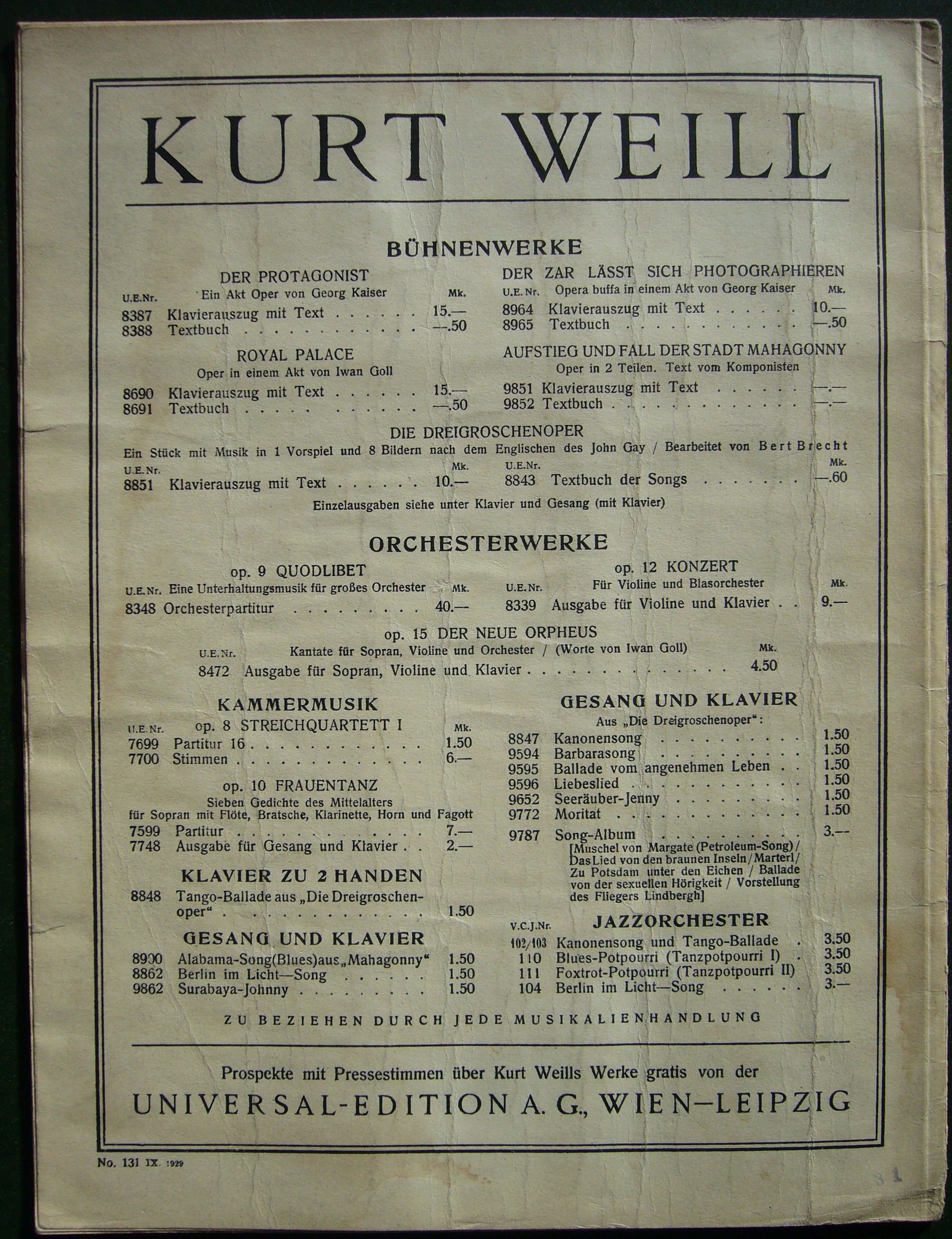

The creation of this back cover plate can be dated quite exactly, because it was also used as the back cover for the publications of the individual songs from the Dreigroschenoper. The copy of the "Tango-Ballade" (UE 8848) printed in the first days of September 1928 still has a back cover with general piano music advertisement, the second edition of the "Kanonen-Song" printed on the last days of November has the new "all Kurt Weill" back cover.
references:
- Stephane Buchon (2005): Le catalogue historique de la maison d’édition musicale Universal-Edition (1901-1932). Doctoral thesis at the Technische Universität Berlin.
- Stephen Hinton & Edward Harsh (2000): Die Dreigroschenoper. Critical Report. Series I, Volume 5 from the Kurt Weill Edition. New York: Kurt Weill Foundation for Music Inc.
- James Fuld (2000): The Book of World-Famous Music. Classical, Popular and Folk. 5th edition. New York: Dover Publications. p. 343-344.
In addition I contacted the following libraries and archives for further information and received important details. I would like to thank: Universal Edition, Felix Bloch Erben, the Austrian National Library, the Kurt Weill Foundation, the Bertolt Brecht Archive, the Morgan Library.
Other UE editions referring to the Dreigroschenoper
Universal Edition published several other works in the late 1920s and early 1930s that refer to the Dreigroschenoper: libretto, extracts of single songs, arrangements by other composers. For completeness I would like to provide some information about these publications as well. That include photos of the covers and the printing runs (taken from the important book by Stephane Buchon, see references above). All these scores - beside the libretto - can be dated through the printer's date on the back cover.
UE 8847
Kanonensong, for voice and piano
arrangement by Norbert Gingold
1. run: 24.09.1928 – 498 copies
2. run: 06.12.1928 – 500 copies
3. run: 05.02.1929 – 1000 copies
further runs after 1932

my copy was the print date "XI. 1928" on the back cover
UE 8848
Zuhälterballade, for voice and piano
arrangement by Norbert Gingold
published under the title „Tango-Ballade“
1. run: 09.10.1928 – 500 copies
2. run: 06.12.1928 – 499 copies
3. run: 07.02.1929 – 499 copies
further runs after 1932

my copy has the print date "IX. 1928" on the back cover
UE 8849
orchestral parts
1. run: 29.10.1928 – 77 copies
further runs after 1932
UE 8849
choral parts
1. run: 27.10.1928 – 596 copies
2. run: 02.01.1929 – 600 copies
further runs after 1932
UE 8850
libretto
1. run: 15.08.1928 – 502 copies
2. run: 12.10.1928 – 120 copies
3. run: 24.11.1928 – 515 copies
no further runs!
In contrast to all other publications mentioned here the libretto was not printed by the Waldheim-Eberle A.G, but by Otto Maass' Söhne Ges. m. b. H. For that reason there is no printer's date on the back cover. In many publications it is stated that copies from these three printing runs can not be distinguished, but that is not correct. There are at least two different variants that can be easily identified from the code on the back cover: One has the code "2338 28", the other one "1398 29".
Interestingly these two variants show some further remarkable characteristics:
2338 28: This variant writes the word "Schiffbauerdamm" correctly on the front page. In addition there are spaces next to the hyphen and the words Wien and Leipzig at the bottom right: "Wien - Leipzig". On the back cover the "Wallfischgasse" is written incorrectly (there is one "l" too many).
1398 29: In contrast this variant has the typo "Schiffbauerdam" (missing an "m" at the end) on the front cover and there are no spaces next to the hyphen: "Wien-Leipzig". On the back cover the "Walfischgasse" is written correctly.
Unfortunately these differences give no hint which one came first because both have different typos. That means - whichever is the first edition - the printing firm corrected a typo and created a new one instead.
UE 9594
Barbara Song, for voice and piano
arrangement by Norbert Gingold
1. run: 27.10.1928 – 500 copies
2. run: 05.02.1929 – 485 copies
3. run: 01.06.1929 – 498 copies
4. run: 06.03.1930 – 500 copies
further runs after 1932
UE 9595
Ballade vom angenehmen Leben, for voice and piano
arrangement by Norbert Gingold
1. run: 30.10.1928 – 500 copies
2. run: 12.12.1928 – 500 copies
3. run: 01.06.1929 – 500 copies
further runs after 1932
UE 9596
Liebeslied, for voice and piano
arrangement by Norbert Gingold
1. run: 20.11.1928 – 500 copies
further runs after 1932
UE 9652
Seeräuberjenny, for voice and piano
arrangement by Norbert Gingold
1. run: 08.01.1929 – 497 copies
2. run: 31.03.1929 – 499 copies
further runs after 1932
UE 9712
Kleine Dreigroschenoper, full score
1. run: 27.03.1929 – 98 copies
further runs after 1932
UE 9713
Kleine Dreigroschenoper, orchestral parts
1. run: 27.03.1929 – 98 copies
further runs after 1932
UE 9772
Die Moritat von Mackie Messer, for voice and piano
arrangement by Norbert Gingold
1. run: 01.06.1929 – 500 copies
further runs after 1932
UE 9787
Ballade von der sexuellen Hörigkeit, for voice and piano
part of a song collection titled „Song Album“
1. run: 01.10.1929 – 500 copies
2. run: 28.04.1931 – 501 copies
further runs after 1932

my copy has the print date "IX. 1929" on the back cover
UE 9863
Ballade vom angenehmen Leben, for voice and piano
arrangement by Gustav Blasser
part of the song album "Von 12 bis 12 funkt Wien"
1. run: 30.10.1929 – 6014 copies
2. run: 13.01.1930 – 4049 copies
further runs after 1932
This publication contains 40 different compositions by various composers and was published by Universal Edition as a book with cardboard covers and an especially designed exterior presentation. Therefore the back cover does not present advertisements from the publishing house like other UE editions, but only the cover design similar to the front cover. That means not printer's date is available and the different runs cannot be distinguished.

UE 9969
7 Stücke nach der Dreigroschenoper, for violin and piano
arrangement by Stefan Frenkel
1. run: 29.03.1930 – 297 copies
2. run: 25.08.1932 – 296 copies
further runs after 1932

my copy has the print date "III. 1930" on the back cover
UE 9969b
7 Stücke nach der Dreigroschenoper, for violin and piano
arrangement by Stefan Frenkel
easy edition
1. run: 25.08.1932 – 496 copies
further runs after 1932
UE 1151
Tonfilm-Musik
Moritat + Seeräuberjenny + Liebeslied + Kanonensong, for voice and piano
accompanying the premiere of the Dreigroschenfilm
1. run: 04.04.1931 – 1000 copies
2. run: 01.06.1931 – 497 copies
3. run: 18.10.1932 – 497 copies
no further runs!
VCJ 102
Tango-Ballade, for jazz orchestra and voice ad lib.
arrangement by Jerzy Fitelberg
I have no information about the publication history, but my copy has the print date „X. 1928“ on the back cover

for all presented photos:
(c) with kind permission of the Universal Edition A.G., Wien
